The orbital velocity of stars in a galaxy
A star orbiting within a spherical galaxy
The force on the star towards the centre of the galaxy depends on the mass of the stars within the sphere bounded by its orbit. (Mass = K1r3)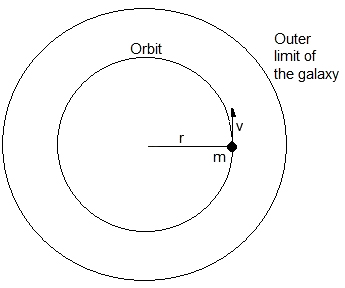 |
The force on the star towards the centre of the galaxy is proportional to 1/r2.
mv2/r = GmK1r3/r2
v2= GK1r2
v = K2r (proportional to r)
A star orbiting outside a spherical galaxy
The star is in a circular orbit about the centre of gravity of the galaxy.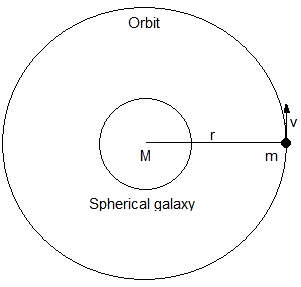 |
The force on the star towards the centre of the galaxy is proportional to 1/r2.
mv2/r = GmM/r2
v2 = GM/r
v = K3/√r (proportional to 1/√r)
A star orbiting within a disc of stars
The force on the star towards the centre of the disc depends on the mass of the stars within the circle bounded by its orbit. (Mass = K4r2)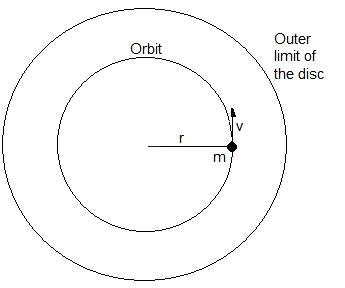 |
The force on the star towards the centre of the disc is proportional to 1/r.
mv2/r = GmK4r2/r
v2= GK4r2
v = K5r (proportional to r)
A star orbiting outside a disc of stars
The star is in a circular orbit in the plane of the disc about the centre of gravity of the disc.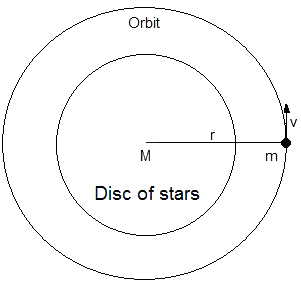 |
The force on the star towards the centre of the disc is proportional to 1/r.
mv2/r = GmM/r
v2= GM
v = K6 (independent of r)
The velocity is only independent of r if the star is orbiting exactly in the plane of the disc. The thickness of the region in which a test particle's velocity is almost constant gets narrower the further it is from the disc. Beyond some distance a star will be too big to be wholly within this region so it's velocity will then be less the further it is from the disc. A hydrogen atom, being tiny, may be within this region at a much greater distance from the disc. So hydrogen emmisions will be indicate a constant velocity much further away from the disc.
A spiral galaxy with a central bulge
Represent a spiral galaxy as a sphere of stars with a surrounding disc.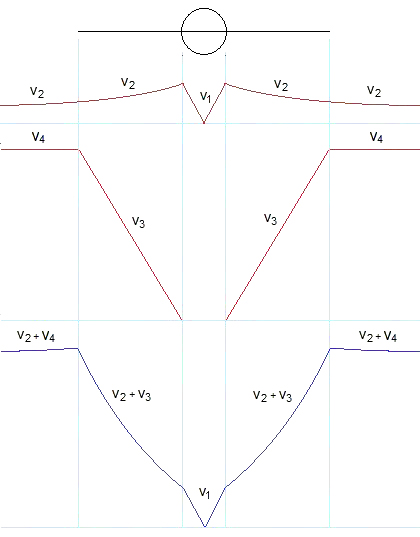 |
| Orbital velocity of a
test mass within the bulge: Orbital velocity of a test mass within the disc: due to the effect of the bulge due to the effect of the disc Total orbital velocity of a test mass within the disc: Orbital velocity of a test mass outside the disc: due to the effect of the bulge due to the effect of the disc Total orbital velocity of a test mass outside the disc: |
v1 =
K2r v2 = K3√r v3 = K5r v2 + v3 v2 = K3√r v4 = K6 v2 + v4 |
The actual shape of the curves depends on the values of K1 and K4. (star density)
The curve seems to correspond to current observations.
So, do we need dark matter to explain the observations?
Test masses in and around a disc
Particles within a disc with no central bulgeIgnoring the bulge and only taking the disc into consideration:
The velocity of a particle orbiting at a distance r from the centre is proportional to r, if disc density is constant. Angular velocity, ϖ = v/r. So, within the disc, ϖ is independent of r. All the particles in the disc rotate at the same angular velocity. In other words the disc rotates as if it were a solid object.
Particles outside the disc
The velocity of a particle orbiting just outside the disc is independent of r. Angular velocity, ϖ = v/r. So, outside the disc, ϖ is proportional to 1/r. In other words the further away the particle is, the lower its angular velocity. The particles further away are overtaken by the nearer ones.
Consider a particle at the edge of the disc overtaking one just outside
There will be an attractive force between them, in addition to gravity (See my Mass and Charge article). This will tend to pull the disc particle out of the disc and the outside particle towards the disc. The disc particle will go round the front of the outside particle and end up outside it, going slower than it was before, and the outside particle go round the back of the disc particle and end up at the edge of the disc going faster than it was before. The outside particle will have changed places with the disc particle. Does this remind you of the behaviour of ‘Shepherd moons’ at the edge of Saturn’s rings?
The formation and evolution of galaxies
1. A lone star passes a spiral galaxy, ‘above’ the plane of the disc. The star experiences a 'radial' force, due to the rotating galaxy below it, causing it to start to move in a circular path parallel to the in the same sense as the disc is rotating (Inertial Frame Dragging). There is also an axial component, attracting the star towards the disc (See my Mass and Charge article). Over time the star ‘spirals’ (helical-spiral) down and eventually becomes a member of the disc.2. A star in the bulge which is not orbiting in the plane of the disc will also experience the force due to Inertial Frame Dragging. The radial component causes its orbit to precess in the same sense as the rotation of the disc. Eventually, the axial component causes the orbit to settle down into the plane of the disc. In this way, over a very long time, the bulge itself will flatten. Of course the stars in the bulge ought individually to affect the stars in the disc (Action and reaction). As the bulge stars are initially in random orbits the axial components will cancel, and have no net effect on the disc. The radial components however are additive, and will tend to pull the disc inwards.
3. So, how did the galaxy form in the first place? Imagine a random group of stars with no net rotation. Two such groups pass each other. The groups will be attracted to each other by gravity. This, on its own, would cause them to move in a hyperbolic path past each other. However, in addition to gravity, there is an another attractive force due to their relative motion (See my Mass and Charge article).This causes the groups to orbit each other and eventually merge, possibly as an Elliptical Galaxy. The new galaxy will have a overall sense of rotation in the plane of the two groups’ original approach. This overall rotation of the galaxy will affect the stars orbiting at an angle to its 'equator' (as in Paragraph 2). and the galaxy will flatten and may eventually form a disc-like structure.
Mike Holden - Nov 2014